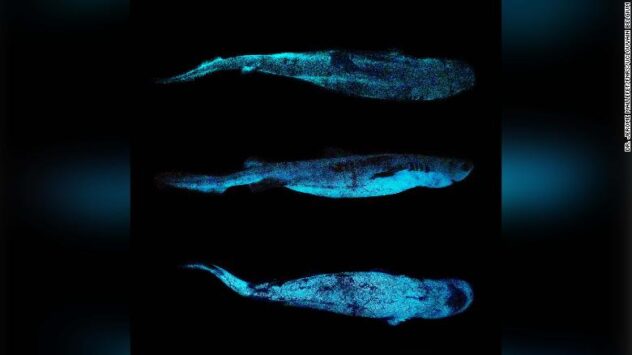
©Dr. Jérôme Mallefet via CNN
Vocabulary:
I will read the words, meanings, and sample sentences. Then, repeat after me.
- vertebrate /VUR-tuh-brit/
- marine /muh-REEN/
- emit /ih-MIT/
- exist /ig-ZIST/
- execute /EK-si-kyoot/
[noun] – an animal that has a spine or backbone
Reptiles, birds, and fish are all vertebrates.
[adjective] – related to the sea or sea transport
The marine wildlife should be protected at all costs.
[verb] – to send out light, sound, or a smell, or a gas or other substance
The factory near the town emits gas that can poison animals.
[verb] – to live, or to be real
He strongly believes that aliens exist.
[verb] – to perform or do something
The actors of the play execute the scenes beautifully.
Article reading:
Please read the whole article. Then, I will check your pronunciation and intonation.
Photos of a glow-in-the-dark shark were shot for the first time by scientists. Dalatias licha, a kitefin shark, is the world’s most massive bioluminescent vertebrate, which grows to almost six feet long. As reported by researchers from the Catholic University of Louvain (UCLouvain) and the National Institute of Water and Atmospheric Research (NIWA), scientists found the fish in the ocean of Chatham Rise, over the east coast of South Island in New Zealand.
Dr. Jérôme Mallefet, head of the marine biology laboratory at UCLouvain, explained that about 57 of the 540 known shark species can emit light through biochemical reaction, completing the process of bioluminescence. Despite being the slowest swimming shark species in the world, Mallefet said that kitefins are “really difficult to observe” as they exist between 200 and 900 meters beneath the oceanbottom. Two other species of the same kind, Etmopterus granulosus (southern lanternshark) and Etmopterus lucifer (blackbelly lanternshark), were also documented executing bioluminescence.
Dr. Jérôme Mallefet, head of the marine biology laboratory at UCLouvain, explained that about 57 of the 540 known shark species can emit light through biochemical reaction, completing the process of bioluminescence. Despite being the slowest swimming shark species in the world, Mallefet said that kitefins are “really difficult to observe” as they exist between 200 and 900 meters beneath the oceanbottom. Two other species of the same kind, Etmopterus granulosus (southern lanternshark) and Etmopterus lucifer (blackbelly lanternshark), were also documented executing bioluminescence.
True or False:
Read the sentences and identify if they are true or false based on the article.
- Dalatias licha is the world’s smallest bioluminescent vertebrate.
- Chemoluminescence refers to the process of emitting light through biochemical reaction.
- The first glow-in-the-dark shark was documented in the Atlantic Ocean.
- Kitefin sharks are difficult to observe because of their depth beneath the ocean’s surface.
- As stated in the article, southern lanternshark and blackbelly lanternshark were also reported doing bioluminescence.
Situational question:
I will read the situation. Then, please answer based on the question. Make sure to use the given keywords in your answer.
Situation: You are reporting about the marine wildlife in front of the class. Give some pieces of advice on how to protect it.
Question: What will be the aftermath if we are not going to protect our marine wildlife?
- The marine wildlife is important because…
- It provides us….
- Thus, we must protect all bodies of water through…
Express Your Opinion:
I will read each sentence. Then, please tell me if you agree or disagree, and why.
- ”Ocean is a mighty harmonist.” — William Wordsworth
- ”The sea, once it casts its spell, holds one in its net of wonder forever.” — Jacques Cousteau
- ”The least movement is of importance to nature. The entire ocean is affected by a pebble.” — Blaise Pascal